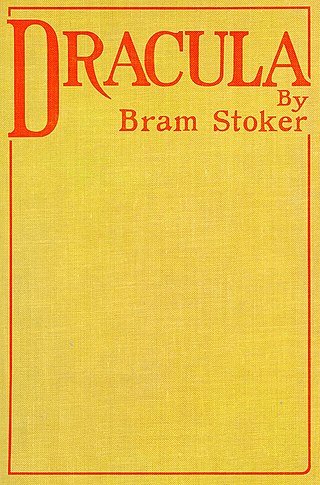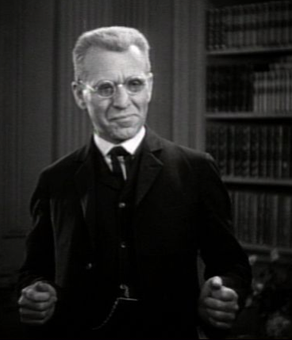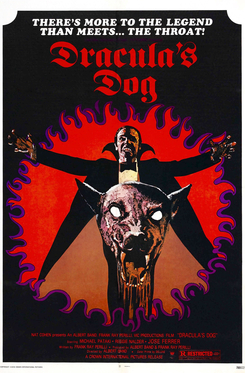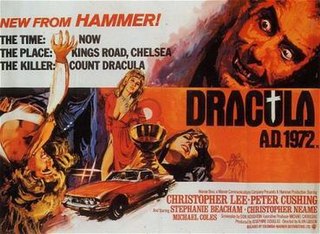Related Research Articles

Dracula is a novel by Bram Stoker, published in 1897. An epistolary novel, the narrative is related through letters, diary entries, and newspaper articles. It has no single protagonist and opens with solicitor Jonathan Harker taking a business trip to stay at the castle of a Transylvanian nobleman, Count Dracula. Harker escapes the castle after discovering that Dracula is a vampire, and the Count moves to England and plagues the seaside town of Whitby. A small group, led by Abraham Van Helsing, investigate, hunt and kill Dracula.

A vampire is a mythical creature that subsists by feeding on the vital essence of the living. In European folklore, vampires are undead creatures that often visited loved ones and caused mischief or deaths in the neighbourhoods which they inhabited while they were alive. They wore shrouds and were often described as bloated and of ruddy or dark countenance, markedly different from today's gaunt, pale vampire which dates from the early 19th century. Vampiric entities have been recorded in cultures around the world; the term vampire was popularized in Western Europe after reports of an 18th-century mass hysteria of a pre-existing folk belief in Southeastern and Eastern Europe that in some cases resulted in corpses being staked and people being accused of vampirism. Local variants in Southeastern Europe were also known by different names, such as shtriga in Albania, vrykolakas in Greece and strigoi in Romania, cognate to Italian 'Strega', meaning Witch.

Vampire literature covers the spectrum of literary work concerned principally with the subject of vampires. The literary vampire first appeared in 18th-century poetry, before becoming one of the stock figures of gothic fiction with the publication of Polidori's The Vampyre (1819), which was inspired by the life and legend of Lord Byron. Later influential works include the penny dreadful Varney the Vampire (1847); Sheridan Le Fanu's tale of a lesbian vampire, Carmilla (1872), and the most well known: Bram Stoker's Dracula (1897). Some authors created a more "sympathetic vampire", with Varney being the first, and more recent examples such as Moto Hagio's series The Poe Clan (1972-1976) and Anne Rice's novel Interview with the Vampire (1976) proving influential.

Legend tripping is a name bestowed by folklorists and anthropologists on an adolescent practice in which a usually furtive nocturnal pilgrimage is made to a site which is alleged to have been the scene of some tragic, horrific, and possibly supernatural event or haunting. The practice mostly involves the visiting of sites endemic to locations identified in local urban legends. Legend tripping has been documented most thoroughly to date in the United States.

Professor Abraham Van Helsing is a fictional character from the 1897 gothic horror novel Dracula written by Bram Stoker. Van Helsing is a Dutch polymath doctor with a wide range of interests and accomplishments, partly attested by the string of letters that follows his name: "MD, D.Ph., D.Litt., etc.", indicating a wealth of experience, education and expertise. He is a doctor, professor, lawyer, philosopher, scientist, and metaphysic. The character is best known through many adaptations of the story as a vampire slayer, monster hunter and the arch-nemesis of Count Dracula, and the prototypical and the archetypical parapsychologist in subsequent works of paranormal fiction. Some later works tell new stories about Van Helsing, while others, such as Dracula (2020) and I Woke Up a Vampire (2023) have characters that are his descendants.

Augustus Montague Summers was an English author, clergyman, occultist, and teacher. He initially prepared for a career in the Church of England at Oxford and Lichfield, and was ordained as an Anglican deacon in 1908. He then converted to Roman Catholicism and began styling himself as a Catholic priest. He was, however, never affiliated with any Catholic diocese or religious order, and it is doubtful that he was ever actually ordained to the priesthood. He was employed as a teacher of English and Latin while independently pursuing scholarly work on the English drama of the 17th century. The latter earned him election to the Royal Society of Literature in 1916.
A psychic vampire is a creature in folklore said to feed off the "life force" of other living creatures. The term can also be used to describe a person who gets increased energy around other people, but leaves those other people exhausted or "drained" of energy. Psychic vampires are represented in the occult beliefs of various cultures and in fiction.
Vrykolakas, also called vorvolakas or vourdoulakas, is a harmful, undead creature in Greek folklore. It shares similarities with numerous other legendary creatures, but is generally equated with the vampire of the folklore of the neighbouring Slavic countries. While the two are very similar, a vrykolakas eats flesh, particularly livers, rather than drinking blood, which combined with other factors such as its appearance bring it more in line with the modern concept of a zombie or ghoul.

Vampire films have been a staple in world cinema since the era of silent films, so much so that the depiction of vampires in popular culture is strongly based upon their depiction in films throughout the years. The most popular cinematic adaptation of vampire fiction has been from Bram Stoker's 1897 novel Dracula, with over 170 versions to date. Running a distant second are adaptations of the 1872 novel Carmilla by Sheridan Le Fanu. By 2005, the Dracula character had been the subject of more films than any other fictional character except Sherlock Holmes.
Vampire hunter or vampire slayer is a fictional occupation in folklore and fiction which specializes in finding vampires, and sometimes other supernatural creatures. A vampire hunter is usually described as having extensive knowledge of vampires and other monstrous or undead creatures, including their powers and weaknesses, and uses this knowledge to effectively combat them.

Nightstalkers is an American comic book series published by Marvel Comics from 1992 to 1994, featuring a trio of occult experts reluctantly banded together to fight supernatural threats. Operating under the business name Borderline Investigations, the team was composed of vampire hunters Blade and Frank Drake and private detective Hannibal King, all of whom had fought Count Dracula in the 1970s series The Tomb of Dracula. They are gathered by Doctor Strange in Nightstalkers #1 to battle an immediate threat, but under Strange's larger, hidden agenda.

Occult detective fiction is a subgenre of detective fiction that combines the tropes of the main genre with those of supernatural, fantasy and/or horror fiction. Unlike the traditional detective who investigates murder and other common crimes, the occult detective is employed in cases involving ghosts, demons, curses, magic, vampires, undead, monsters and other supernatural elements. Some occult detectives are portrayed as being psychic or in possession of other paranormal or magical powers.

Dracula's Dog, also known as Zoltan... Hound of Dracula, is a 1977 American supernatural horror film directed by Albert Band and starring Michael Pataki and José Ferrer. Its plot revolves around a Doberman Pinscher who is turned into a vampire by a member of the Dracula family, who is also a vampire.

Taste the Blood of Dracula is a 1970 British supernatural horror film produced by Hammer Film Productions. Directed by Peter Sasdy from a script by Anthony Hinds, it is the fifth installment in Hammer's Dracula series, and the fourth to star Christopher Lee as Count Dracula, the titular vampire. The film also features Geoffrey Keen and Gwen Watford.

Dracula A.D. 1972 is a 1972 British horror film, directed by Alan Gibson and produced by Hammer Film Productions. It was written by Don Houghton and stars Christopher Lee, Peter Cushing and Stephanie Beacham. Unlike earlier films in Hammer's Dracula series, Dracula A.D. 1972 had a contemporary setting in an attempt to update the Dracula story for modern audiences. Dracula is brought back to life in modern London and preys on a group of young partygoers that includes the descendant of his nemesis, Van Helsing.

Peter Underwood was an English author, broadcaster and parapsychologist. Underwood was born in Letchworth, Hertfordshire. Described as "an indefatigable ghost hunter", he wrote many books which surveyed alleged hauntings within the United Kingdom - beginning the trend of comprehensive regional 'guides' to (purportedly) haunted places. One of his well-known investigations concerned Borley Rectory, which he also wrote about.

"Fragment of Novel" is an unfinished 1819 vampire horror story written by Lord Byron. The story, also known as "A Fragment" and "The Burial: A Fragment", was one of the first in English to feature a vampire theme. The main character was Augustus Darvell. John William Polidori based his novella The Vampyre (1819), originally attributed in print to Lord Byron, on the Byron fragment. The vampire in the Polidori story, Lord Ruthven, was modelled on Byron himself. The story was the result of the meeting that Byron had in the summer of 1816 with Percy Bysshe Shelley where a "ghost writing" contest was proposed. This contest was also what led to the creation of Frankenstein according to Percy Bysshe Shelley's 1818 Preface to the novel. The story is important in the development and evolution of the vampire story in English literature as one of the first to feature the modern vampire as able to function in society in disguise. The short story first appeared under the title "A Fragment" in the 1819 collection Mazeppa: A Poem, published by John Murray in London.
Leslie Shepard was a British author, archivist, and curator who wrote books on a range of subjects including street literature, early film, and the paranormal.
Hrabě Drakula is a Czechoslovakian 1971 black and white TV film adaptation of Bram Stoker's original novel Dracula.
References
- ↑ Ellis (1993), p.13-39
- ↑ R. D. Altick, To Be in England (1969), 194-95, and various press reports,cited in Ellis (1993) 19-20
- ↑ Medway, Gareth Lure of the Sinister: The Unnatural History of Satanism, New York University Press (1 April 2001)
- ↑ Hampstead and Highgate Express, 6 February 1970, 26; 13 February 1970, 25; 20 February 1970, 1, 27; 27 February 1970, 6. Cited in Ellis (1993) 20-21; some also in Farrant (1991) 6-8.
- 1 2 "The Bloody Truth About Vampires". National Geographic News. 26 October 2016. Archived from the original on 27 October 2016.
- ↑ Hampstead and Highgate Express,6 March 1970, 1; Hampstead and Highgate Express, 27 February 1970, 1; Manchester (1991) 69-70, 75; Ellis (1993) 24
- ↑ Such behaviour exemplifies, in an extreme form, a fondness for legend tripping. Hampstead and Highgate Express, 13 March 1970, 1; The Evening News 14 March 1970, 1; Ellis (1993) 24-25.
- ↑ Ellis, Bill. Raising the Devil: Satanism, New Religions and the Media (University Press of Kentucky, 2000), 215-36.
- ↑ Melton, J. Gordon. The Vampire Book: The Encyclopedia of the Undead (Detroit, Washington and London, Visible Ink Press, 1994)
- ↑ Camden, Highgate and Hampstead Record, 21 August 1970, 1; 28 August 1970, 1; 2 October 1970, 1.
- ↑ Hornsey Journal, 28 August 1970, 36
- ↑ The Sunday People, 8 April 1973; Ellis (1993) 30-31.
- ↑ Press coverage was very extensive, in both local and national papers, see Ellis (1993) 31-33 and the list of press sources in his note 81.
- ↑ Matthew Beresford (15 December 2008). From Demons to Dracula: The Creation of the Modern Vampire Myth . Reaktion Books. pp. 180–. ISBN 978-1-86189-742-8.
- ↑ Garcia, Francisco; Bethell, Chris (5 February 2020). "The Decades-Long Rivalry of London's Two Vampire Hunters". Vice.com. Vice Media . Retrieved 13 February 2020.
- ↑ Ellis, Bill. "The Highgate Cemetery Vampire Hunt". Folklore. 104.
- ↑ Dampyr issue 45, Bonelli official website.
- ↑ "Episode 388: The Vampire Hunters of Highgate Cemetery". directory.libsyn.com. Retrieved 3 November 2019.
- ↑ A Facebook post made by the band.